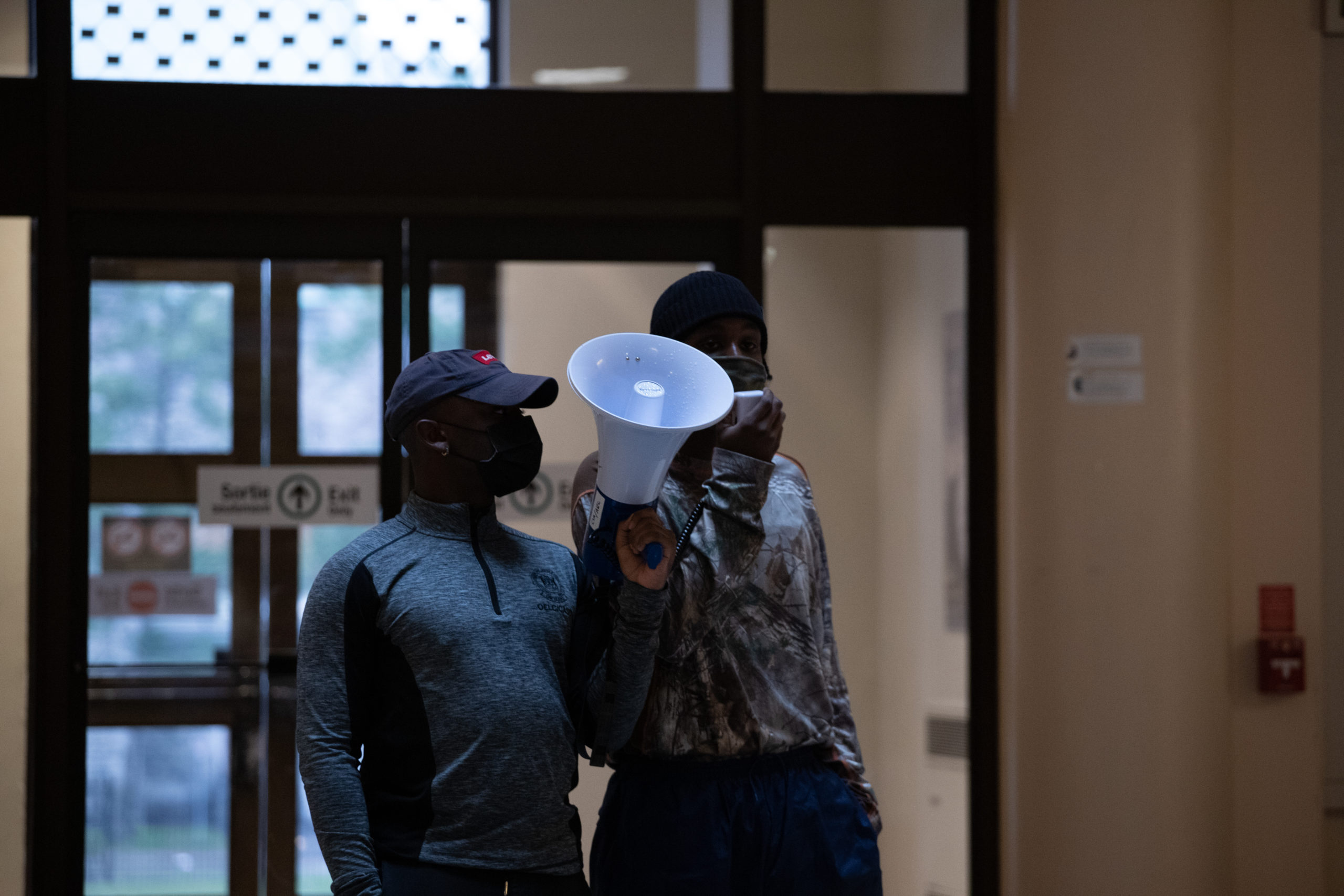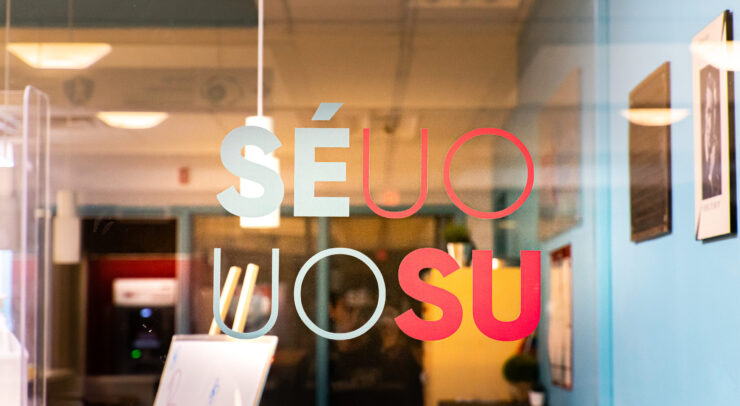Protester have been occupying Tabaret Hall’s lobby since Friday afternoon
“Black lives, they matter here; Black lives they matter here, the people united will never be divided,” chanted protestors outside of Morisset Hall on Dec. 4.
Roughly 20 people braved the rain and cold to partake in a protest over the legitimacy of the University of Ottawa’s new Action Committee on Anti-Racism and Inclusion.
Eventually, the protest became a sit-in in Tabaret Hall as protestors demanded a meeting with Jacques Frémont, president of the University of Ottawa, and Jill Scott, provost and vice-president of academic affairs.
As of the online publication of this article, the protesters had been occupying the lobby of Tabaret hall for 65 hours.
Organized by the University of Ottawa Students’ Union (UOSU) in conjunction with the Black Student Leaders Association (BSLA) and OPIRG, various student government leaders were present during the protest including student Jamal Koulmiye-Boyce, Jason Seguya, UOSU equity commissioner, Judy El-Mohtadi, former equity commissioner for the UOSU, Dilaye Detsa, University of Ottawa alumni as well as UOSU president Babacar Faye.
“I am really proud of the amount of students that showed up and shout out to everyone who did,” Seguya said. “It really shows once again that we’re presenting a unified front [to the administration].”
Directly addressing concerns at U of O
Both Seguya and Faye gave speeches to the crowd indoors before taking some time to get comfortable for the sit-in.
The Fulcrum spoke to the coordinators of the protest about the future plans for uRacism in combating anti-Black racism on campus.
“We decided to do the [uRacism panel] which would give students an idea of why we came to the decision to leave the [advisory] committee,” said El Mohtadi. “The day or two days before we got to that event, there was an email saying that [the advisory committee had] been dissolved without any consultation.”
The previous advisory committee, of which Desta, El-Mohtadi and Seguya were a part of, was officially dissolved on Nov. 23. Frémont announced the creation of an action committee the same day that would have all new representatives.
Continuing on this, Desta added that the advisory committee “did initially bring forth the idea” for the advisory committee to become an action committee.
“They didn’t state [U of O policy] as the reason why that wasn’t possible; they just told us that ‘we can’t respond to every incident of racism that occurs on campus.’”
Koulmiye-Boyce spoke about “the goal of transparency” at the protest on the first day of the sit-in, saying that uRacism organizers want students to be aware of the situation with the U of O administration.
“We’re not trying to reinvent the wheel, the U[niversity] of T[oronto] has a very good independent anti-racism office,” said Koulmiye-Boyce. “A lot of these changes that the University is proposing seem really good on paper but are actually extremely harmful [to BIPOC students].”
Seguya seconded this thought, stating that the protests main goal is “the introduction of an anti-racism office at the University of Ottawa. At [the U of O] there’s only one equality, diversity, and inclusion department underneath the one administration.”
“At a school like ours, that has a majority white leadership that is not responding to these issues is very problematic. [Since] there is not anyone who’s specific job is working on anti-Black racism on campus [there is no concerted effort to focus on anti-Black racism],” said Seguya.
Eight hours into the sit-in, an IG TV video was released on the uRacism Instagram page speaking on the recent appointment of professor Boulou Ebanda de B’Béri as special advisor on anti-racism and inclusion.
The video statement included Dilaye Detsa and Jamal Koulmiye-Boyce, who spoke about the issue of tokenizing a Black man for the legitimacy of the action committee.
“This is a clear weaponization of identity politics. There has been a Black man appointed to the role [Professor B’Béri], yet from our conversation it is clear that he lacks the knowledge to implement real systemic change,” said Koulmiye-Boyce.
In addition to the comments on the new special advisor, they critiqued the co-chair of the action and inclusion committee, Noël Badiou.
“In exact verbatim from the co-chair [Badiou] of the new action committee: ‘He does not answer to us. He does not answer to the students, or the community,’ ” continued Koulmiye-Boyce.
Desta stressed the importance of change on the part of the U of O administration; “we need central administration to take us seriously and actually reads the demands and respond to us in a prompt manner.”
Plans to extend the protest
The morning of Dec. 5, the sit-in was still ongoing after protestors spent the night in Tabaret Hall waiting for Frémont and Scott.
At 1 p.m. on Dec. 5 (24 hours after the protest began) the uRacism Instagram account provided an update on the protest explaining they plan to occupy the space until the U of O administration responds.
Inside Tabaret Hall, Koulmiye-Boyce said, “We’ve officially been occupying Tabaret Hall for 24 hours now. We are yet to hear from the central administration with tangible action. We are tired but we will not give up until we have our demands met: decolonization and anti-racism are verbs, not nouns and they must be backed by action.”
As of Dec. 7 the uRacism group continued to provide updates throughout the three days that they occupied the space, with Instagram TV videos every 24 hours.
Seguya spoke to the Fulcrum with an update 53 hours into the sit-in, saying that, “we haven’t so much as received an email from Jacques Frémont or Jill Scott confirming that they see what we’re saying and are in discussion about it.”
“Regardless of how long it is we’re intending to put out a statement that does condemn the lack of action on it,” said Seguya.
The uRacism group encourages all students to continue in the fight against anti-Black racism on campus and implores the administration to take action sooner rather than later.








